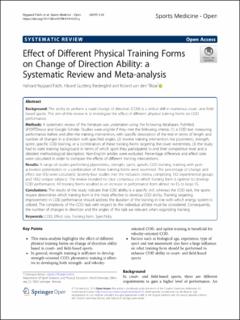| dc.contributor.author | Falch, Hallvard Nygaard | |
| dc.contributor.author | Rædergård, Håvard Guldteig | |
| dc.contributor.author | van den Tillaar, Roland | |
| dc.date.accessioned | 2020-06-30T12:52:44Z | |
| dc.date.available | 2020-06-30T12:52:44Z | |
| dc.date.created | 2019-12-23T21:09:25Z | |
| dc.date.issued | 2019 | |
| dc.identifier.citation | Falch, H. N., Rædergård, H. G. & van den Tiller, R. (2019). Effect of different physical training forms on change of direction ability: a systematic review and meta-analysis. Sports Medicine - Open, 5: 53. doi:. | en_US |
| dc.identifier.issn | 2198-9761 | |
| dc.identifier.uri | https://hdl.handle.net/11250/2660106 | |
| dc.description.abstract | Background: The ability to perform a rapid change of direction (COD) is a critical skill in numerous court- and field-based sports. The aim of this review is to investigate the effect of different physical training forms on COD performance. Methods: A systematic review of the literature was undertaken using the following databases: PubMed, SPORTDiscus and Google Scholar. Studies were eligible if they met the following criteria: (1) a COD test measuring performance before and after the training intervention, with specific description of the test in terms of length and number of changes in a direction with specified angles, (2) involve training intervention like plyometric, strength, sprint, specific COD training, or a combination of these training forms targeting the lower extremities, (3) the study had to state training background in terms of which sport they participated in and their competitive level and a detailed methodological description. Non-English articles were excluded. Percentage difference and effect sizes were calculated in order to compare the effects of different training interventions. Results: A range of studies performing plyometrics, strength, sprint, specific COD training, training with post-activation potentiation or a combination of these training forms were examined. The percentage of change and effect size (ES) were calculated. Seventy-four studies met the inclusion criteria, comprising 132 experimental groups and 1652 unique subjects. The review revealed no clear consensus on which training form is optimal to develop COD performance. All training forms resulted in an increase in performance from almost no ES to large ES. Conclusions: The results of the study indicate that COD ability is a specific skill, whereas the COD task, the sports require determines which training form is the most effective to develop COD ability. Training targeting improvement in COD performance should address the duration of the training in line with which energy system is utilized. The complexity of the COD task with respect to the individual athlete must be considered. Consequently, the number of changes in direction and the angles of the task are relevant when organizing training. Key Points: This meta-analysis highlights the effect of different physical training forms on change of direction ability based in court- and field-based sports. In general, strength training is sufficient to develop strength-oriented COD, plyometric training is effective in developing both strength- and velocity-oriented COD, and sprint training is beneficial for velocity-oriented COD. Factors such as biological age, experience, type of sport and test assessment also have a large influence on what training form should be performed to enhance COD ability in court- and field-based sports | en_US |
| dc.language.iso | eng | en_US |
| dc.publisher | Springer Open | en_US |
| dc.rights | Navngivelse 4.0 Internasjonal | * |
| dc.rights.uri | http://creativecommons.org/licenses/by/4.0/deed.no | * |
| dc.title | Effect of different physical training forms on change of direction ability: a systematic review and meta-analysis | en_US |
| dc.type | Peer reviewed | en_US |
| dc.type | Journal article | en_US |
| dc.description.version | publishedVersion | en_US |
| dc.rights.holder | © 2019 The Author(s) | en_US |
| dc.subject.nsi | VDP::Samfunnsvitenskap: 200::Samfunnsvitenskapelige idrettsfag: 330 | en_US |
| dc.subject.nsi | VDP::Medisinske Fag: 700::Idrettsmedisinske fag: 850::Bevegelseslære: 852 | en_US |
| dc.source.pagenumber | 37 | en_US |
| dc.source.volume | 5 | en_US |
| dc.source.journal | Sports Medicine - Open | en_US |
| dc.identifier.doi | 10.1186/s40798-019-0223-y | |
| dc.identifier.cristin | 1763793 | |

